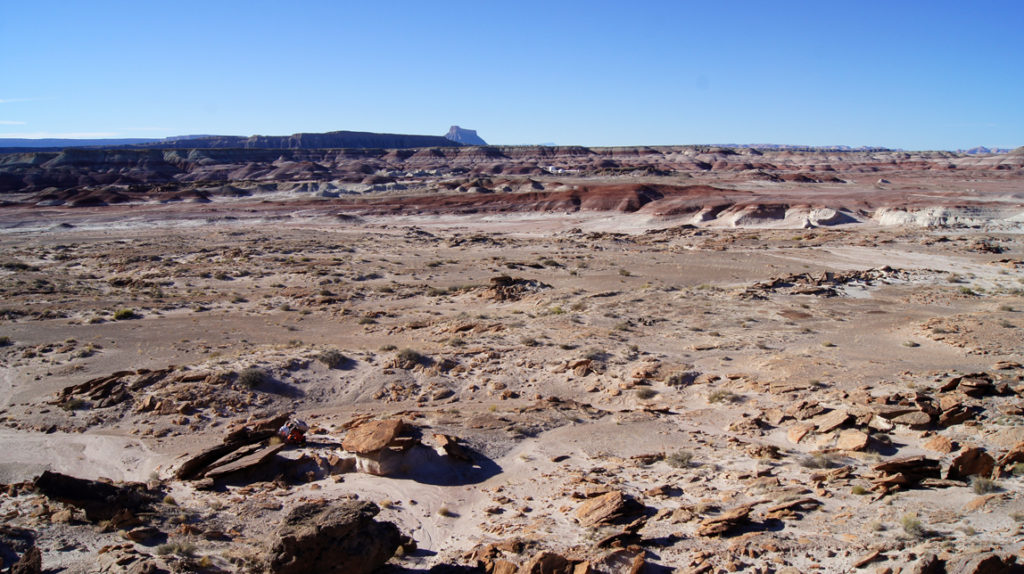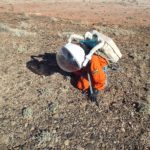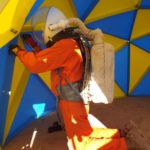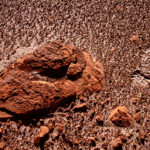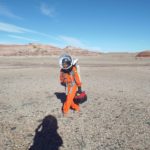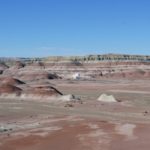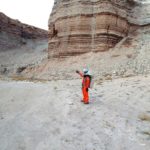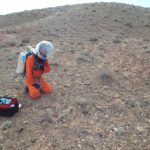This report submitted by Alexandre Mangeot, Crew Commander.
For these 60-day reports I asked my crew mates to write about this mission from their personal perspectives. I wanted us to share more than the pictures, the science and technology reports and food recipes. I wanted us to share our feelings as much as it is humanly possible with simple words!
So the crew wrote their parts independently during these few days and the result is just mind-blowing…
इस ६० दिनों के रेपोर्ट के लिये मैंने अपने दल के सभी साथियों से यह अनुरोध किया की वो इस मिशन से जुड़े हुए अपने काम और अपनी व्यक्तिगत भावनाएँ सरल शब्दों में साझा करें जो की इस मिशन के किसी भी अन्य रेपोर्ट से कहीं ज़्यादा हों…
अतः मेरे साथियों ने इन दिनो समय निकालकर अपने विचारों को लिखा और उसका परिणाम असाधारण है!
Для написания отчета о 60 днях в симуляции я попросил сотоварищей по команде поделиться своими впечатлениями о миссии. Я хотел, что мы поделились с миром чем-то большим, чем просто красивые фотографии, научные и инженерный отчеты, рецепты марсианских блюд. Я хотел рассказать о наших человеческих чувствах в простых словах!
Каждый член экипажа описал свои ощущения от полученного опыта и результат превзошел все ожидания…
今日までの60日間を振り返るこのレポートを書くにあたって、僕はクルーがそれぞれ自らの言葉で、これまでのミッションを語ることが相応しいと思った。写真でもなく、レポートでもなく、クルーたちの生の言葉を、皆さんに届けたいと思った。僕はクルーたちに、できるだけシンプルに、それぞれの想いを記すよう指示した。
そんな訳でクルーたちはここ数日のうちに、思い思いに僕にこんな文章を書いてよこしたんだ。集まってきた文章を読み、僕はただただ目を疑うばかりだった。
Pour ce sol 60 rapport, j’ai demandé à mes membres d’équipages d’écrire à propos de cette mission depuis leurs points de vue respectifs. Je voulais que nous partagions plus des photos, des rapports scientifiques et technologiques et des recettes de cuisine. Je voulais que nous partagions nos sentiments autant qu’il est humainement possible de le faire avec de simples mots!
Et donc les membres d’équipage ont écrit leurs parties indépendamment durant ces quelques jours et le résultat est édifiant…
अनुश्री श्रीवास्तव (Annushree Srivastava) – Crew Biologist
मंगल ग्रह से जुड़े अनुसंधानों की मेरी यात्रा सन २०१४ से प्रारंभ हुई जब मैं MDRS से एक CapCom के तौर पर जुड़ी। इस काम को करते हुए यह मेरे जीवन का पहला अवसर था जब मैंने मानव द्वारा मंगल ग्रह की खोज के विचार को इतने क़रीब से जाना और समझा । CapCom का यह काम मेरे लिए अत्यंत ही ख़ुशी देने वाला होता था क्योंकि मुझे लगता था की कहीं ना कहीं मैं इस काम के द्वारा मैं अंतरिक्ष से जुड़े अपने सपने के क़रीब जाती जा रही थी। और मुझे लगता था की मेरा यह काम यदि मैं पूरी तन्मयता से करती हूँ तो यह मंगल ग्रह से जुड़े वैज्ञानिक अनुसंधानों और वहाँ एक सभ्यता बसाने की ओर मेरा एक छोटा लेकिन महत्वपूर्ण योगदान हो सकता है। इसलिए मैंने एक CapCom के तौर पर अपनी ज़िम्मेदारियाँ जितने बेहतर तरह से हो सकती थी निभाने का प्रयास किया । मेरे CapCom कार्यकाल के दौरान Mission Support के कई सदस्यों ने मुझे MDRS (Utah) जाने और Mars Simulation के दल में सम्मिलित होने और आवेदन भेजने के लिए प्रोत्साहित किया। सामान्य MDRS Rotation के लिये शोध प्रस्ताव लिखते समय मैंने यह नहीं सोचा था की यह पत्र एक दिन मुझे MARS१६० जैसे महत्वकांशी और अभूतपूर्व Mission का हिस्सा बनाएगा। यह जानकर की Mars१६० Mission की प्रमुख शोधकर्ता (Principal Investigator) Shannon Rupert मुझे Crew Biologist के तौर पर इस मिशन का हिस्सा बनाना चाहतीं है, मेरे उत्साह और ख़ुशी का ठिकाना ना रहा। लेकिन इसके साथ ही साथ मेरे कंधों पर एक बड़ी ज़िम्मेदारी का एहसास मुझे हुआ क्योंकि यह मिशन अलगाव के प्रयोग (isolation experiment) से कहीं ज़्यादा वैज्ञानिक संचालनों (science operations) पर आधारित था।
एक Crew Biologist के तौर पर मेरा शोध तीन प्रमुख विषयों पर आधारित है: Lichen की विविधताओं को तलाशना और उनका अभिलेख, hypoliths की परिस्थितिकि और Utah desert में उनकी प्रतिशत प्रचुरता, और अत्यंत प्राचीन gypsum की तहों में सूक्ष्मजीवियों की तलाश। यह अध्ययन धरती पर जीवन की विविधताओं पर शोध के साथ साथ मंगल ग्रह पर जीवन की तलाश में महत्वपूर्ण योगदान देने वाला होगा। विशेष रूप से, धरती के ऐसे वातावरण और परिस्थितिकि में सूक्ष्म जीवाणुओं, मुख्यतः halophiles (salt-loving microbes), की तलाश करना जो की सामान्यतः जीवन के लिये अनुकूल नहीं समझे जाते है, दीर्घकालीन Mars१६० Mission के महत्वपूर्ण लक्ष्यों में से एक है। यह मिशन Utah Desert में MDRS और Canadian Arctic में FMARS में संचालित होगा और दोनों ही स्थानो पर जहाँ की इस्थितियाँ Mars के समान है इन जीवाणुओं पर शोध करेगा। शोध का यह विषय मंगल ग्रह पर जीवन की तलाश के लिए मुख्य रूप से प्रासंगिक है। यह मिशन मंगल ग्रह की परिस्थितियों में साथ ही साथ भारी spacesuit पहनकर वैज्ञानिक प्रक्रियाओं का संचालन करने में मानव की कार्यक्षमता की भी जाँच करता है। इस मिशन के दौरान हम ‘धरती’ पर स्थित वैज्ञानिकों से नियमित रूप से संपर्क में रहते हैं। यह वैज्ञानिक मुख्य रूप से NASA Ames Research Centre और Canadian Museum of Nature में स्थित हैं।
इस तरह के मिशन पर काम करने का और इससे जुड़ी हुई चुनौतियों का सामना करने का यह मेरा पहला अनुभव है। मेरे दल के सभी साथी पहले इस तरह के लघुकालीन मिशन से जुड़े रह चुके हैं। अब तक इस मिशन पर काम करके मैंने विज्ञान और मंगल पर मानवीय आबादी इस्थापित करने के दृष्टिकोण से बोहोत कुछ जाना और सीखा, लेकिन इस मिशन का हिस्सा बनकर मैंने यह पहली बार महसूस किया की मंगल ग्रह तक पहुँचने के लिए हम जितनी भी दूरी तय करते हैं, उतनी ही गहराई हमें अपने अंदर लानी होती है। क्योंकि यह ‘यात्रा’ आसान नहीं। मुझे लगता है की मंगल ग्रह पर जाने का अर्थ स्वयं को भूल जाना भी है। इस कार्य को करते हुए आप अनुभव करते हैं की आपने एक नये स्वयं को जाना है या फिर उसकी खोज की है। अतः मुझे लगता है की मंगल ग्रह की यात्रा विज्ञान और मानव आबादी की इस्थापना करने से कहीं ज़्यादा ख़ुद की क्षमताओं की खोज भी है। इस तरह के मिशन की महत्ता और इससे जुड़े हुए अनुभव आपको और भी विनम्र और सरल बनाते हैं। इस मिशन का हिस्सा बनकर मैंने यह जाना।
Jon Clarke – Crew Geologist
As a geologist I have learned much on the expedition. I have been able to build extensively on my previous studies of the sedimentary and landscape history of the MDRS field area. I have also been able to measure basic soil properties in support of the hypolith research to assist identification of the environmental parameters controlling their distribution.
The significance of this increase in scientific understanding has been that it has been acquired entirely while operating under analogue field conditions, while wearing simulated space suits, using the quadbikes, electric rover, and the Hab car for mobility, and with all the restrictions of limited communications over the radio in the field and in limited internet resources in the station. This has shown that it is possible to do useful science not only on singe EVAs as in the past, but continuously, as part of a multi-disciplinary science program, over several months, under.
Also instructive has been working in the larger context of mission support. While all crews at MDRS work within the mission support framework we, because of the extended mission, have learned more about the challenges involved in this process. The familiar questions of how to balance control and autonomy have frequently appeared and the lessons directly applicable to Mars missions where expectations of control by mission control will be modified by the reality of autonomy through imposed by time lags and communication bandwidth.
Many people have said to me “but what will you do while you are there?” The reality of station life is constant activity, much of it routine and labour intensive. Living and working here for nearly three months has shown the importance of efficient facility design and the desirability of automating as many routine operations as possible. These lessons can only be learned by building a station such as MDRS and then incorporating the lessons into new stations which can be then tested by future crews.
Another common expectation have encountered is that people living in close confines like us, will end up in a nasty mess of conflict and other interpersonal problems. The reality has been quite different. We have had few disagreements between us and I am looking forward to working with everyone in the second half of the mission. Life here is nothing like the clichés of bad science fiction or reality TV!
Claude-Michel Laroche – Ingénieur de bord
La science est le point central de la première moitié de la mission Mars 160. Pour moi, en tant qu’ingénieur d’équipage, je n’ai pas beaucoup de responsabilité concernant les objectifs et résultats scientifiques. Mon rôle est de faire en sorte que ceux qui réalisent les objectifs scientifiques aient les outils et les ressources ainsi que le meilleur environnement possible, pour leurs permettre d’en faire le plus possible dans une période de quatre-vingt jours. Mon rôle est d’arrière-plan.
Le Hab vieillissant est maintenant entouré par un complexe de nouveaux bâtiments. Le Hab, qui est maintenant âgé de seize ans, a encore certains de ses systèmes originaux. Faire en sorte que tout fonctionne de façon optimale en tout temps est un défi de difficulté sans cesse croissante. Ceci étant dit, je pense que le «Mars Desert Research Station» est un des meilleurs endroits au monde pour simuler les premiers moments de l’humanité sur Mars. Cette station a besoin de beaucoup d’amour mais est un des meilleurs centres scientifiques de simulation d’habitation en milieu extrême. Le chauffe-eau, les systèmes de pompage, les nouvelles combinaisons spatiales, le système d’échangeur et de chauffage d’air, la distribution d’électricité, nos installations d’activités physiques ainsi que quelques inspections structurelles ne sont que quelques-uns des systèmes qui ont requis mon attention au cours de ces huit dernières semaines.
De plus, j’ai été appointé comme opérateur principal pour le “projet plantes”. Sous la supervision d’Heater Hava en tant que principale investigateur et avec l’aide de Daniel Zukowski et Dixon Dick comme support de projet et ingénieurs systèmes ainsi que Yusuke Murakami et Alexandre Mangeot comme aide principale pour le projet, nous avions à établir un système fonctionnel permettant d’évaluer les modifications de comportement d’un équipage à l’aide d’un système informatisé qui supervise l’états des plantes, évalué la proximité de l’équipage des plantes et qui permet en plus de surveiller les signes vitaux et de santé de l’équipage. Cette moitié de mission à eu comme point central d’assurer que tous les systèmes soient opérationnels et de trouver et corriger tous les problèmes, pour au final être prêt pour un déploiement en Arctique.
Cette mission a demandé un lot de travail qui s’est montré être exigeant et ardu du premier au dernier jour, certaines semaines ont même été exceptionnellement exténuantes, particulièrement celles où nous devions déployer le projet plante. Je suis particulièrement fier des accomplissements de chacun des membres de l’équipage qui ont été réalisés dans les temps alloués et les limitations de communications que nous avons dû affronter. L’ensemble de l’équipage s’est unis dans le but d’accomplir les objectifs que nous nous sommes données ainsi que ceux demandés par les équipes de recherche. Nous allons avoir beaucoup de travail durant les deux semaines restantes de cette partie de la mission. Je peux m’avancer en disant que cette première moitié de la mission est déjà un haut fait et rend la seconde moitié en Arctique encore plus difficile à accomplir pour atteindre un niveau de qualité équivalent. Avons-nous tout accompli parfaitement? Sommes-nous l’équipage idéal pour aller sur Mars? Surement pas, mais le but est d’apprendre pour en arriver au point ou l’humanité va pouvoir vivre sur Mars.
Annalea Beattie – Crew Journalist
The weather has turned and government has changed since the last time we wrote to you but we are on Mars and our world is very small. We could almost be anywhere.
So much about life is routine and our lives here are like that too. Time management is something we have had to learn. During the middle phase of our mission the daily briefing and evening debriefing became an important part of our day. These regular meetings gives us the opportunity to balance our work load efficiently, often amongst competing demands, so that we can work as part of a team. I’ve learnt to move my own research (which tests out how to improve the data through experiments with the value, tools and techniques of geological field drawing in sim), into second or third or fourth place, especially when hours of paper work are required. But I’ve still spent more hours drawing in the spacesuit than I could have ever imagined possible. And during this time I’ve also been on plenty of EVAs as the cross-trained hypolith generalist. My own research has developed because it is totally embedded in the science within this Mars-like analog environment. This is the best learning for me and a great opportunity to explore something I love.
And for me one other thing stands out clearly in the last month and this is something that makes our day sing along. The crew now know each other. We had a feeling it could be good for us when we all met but during the last month I think I really appreciate what each crew member brings to the mission. Part of this is that I notice how we have learnt to care and support one another while working together and part of it means respecting each others individual needs and boundaries. For me, our best times as a crew are when we eat a meal and relax together on a well deserved day off!
Анастасия Степанова (Anastasiya Stepanova) – Ответственная за здоровье и безопасность экипажа
Я начала эту миссию как журналист экипажа, а заканчиваю как ответственная за здоровье и безопасность, ассистент микробиолога по лабораторной работе. В космических экспедициях сочетание множества навыков и успешное выполнение совершенно различных задач играет решающую роль при отборе в экипаж. На Марсианской исследовательской станции в пустыне параллельно мы работаем сразу над несколькими проектами. Опыт, полученный за последние три месяца, вселил в меня уверенность, что человек может быстро учиться, продуктивно реагировать на непредвиденные ситуации, много работать и справляться с любыми трудностями. Правда, только при одном условии – при наличии великой цели! Той сильной мотивации, которая способна разбудить внутренние силы и помочь достичь того, что прежде казалось непостижимым. Миссия Марс 160 проверяет на прочность нашу целеустремленность. Насколько сильно мы хотим воплотить свою мечту? Что мы готовы сделать для этого? Где заканчиваются наши пределы?
Миссия Марс 160 протестировало то, что не проверяли другие космические организации – собрала экипаж, без предварительной тренировки на совместимость; применила новые виды отчетности для центра управления миссией; провела микробиологические исследования гиполитов, галофилов и лишайников; установила новую биорегенеративную систему жизнеобеспечения; использовала полевые рисунки для дополнения, собранных научных данных; сравнила процедуру сбора образцов в скафандрах и без. Все это в условиях симуляции жизни на Марсе.
С момента нашего пробуждения и до отхода ко сну мы учимся каждый час и каждый день на Марсианской исследовательской станции. Инженерия, информатика, геология, микробиология, строительство, сбор проб, написание статей, грамматика английского языка, сельское хозяйство, рисование, оказание первой помощи, съемки видео, приготовление пищи, уборка, спортивные тренировки, оригами, взаимопонимание, внутренняя работа и умение быть лучшим сотоварищем! Этот драгоценный опыт только первые небольшие шаги на пути к Марсу.
村上祐資 (Yusuke Murakami) – 副隊長
「あなたにとって、sim(Mars Analog Simulation: 模擬火星実験)とはなんですか?」ミッションが始まる前、Mars160のディレクターであるシャノンが、僕らを集めこう問いかけた。そしてこうも言った「それぞれが違う認識を持っているということを、心しておきなさい」と。
僕は、人間の想像力を信じている。想像力の欠如-すなわち無関心さ-は、ときに重大な問題をミッションにもたらすことがある。遠く、遠く、想像力という宇宙船に乗って、僕らはどこまでも行ける。関心は人間であることの証であり、無関心さはその人となりを物語る。そして僕は信じている。想像力の淵源は経験であると。シャノンが言った、それぞれが想像するsimの違い。僕らはそれをどうやって測り合うことができるだろう。僕らは「火星」という、同じ関心を持ってここにやってきた。それ以外にお互いを測り合う術を持っていなかった。けれど僕らは今日まで、ここMDRSという同じ屋根の下で、生活を共にしてきた。いつも共に目覚め、いつも共に食べ、いつも共に笑った。点と点が線でつながり輪郭を描くように、積み重ねてきた同じ経験によって縁取られた僕らの想像力が、一つの形となりチームのなかに芽生えつつあることを、僕は日々実感している。
「日常」の生活と、「ミッション」を送る暮らしの間に、境目はあるだろうか。僕はないと思っている。もしも境目がないのなら、宇宙の暮らしは一体どんな姿をしているのだろう。その答えを見つけたくて僕はここにいる。宇宙ミッションには必ず、明確な目標というゴールがある。だからだろうか。カウントダウンの目盛を刻みながら、ただひたすらな真っすぐな一本道の上を突き進んでいくことができる、そんなチームを好む傾向がある。けれども僕らのチームは当初こそそうであったが、今では目標に向かって気を抜かず邁進しつつも、ときに寄り道をし、気に入った道を行ったり来たりし、立ち止まって談笑を楽しむ、そんな穏やかで実りのある関係を築いている。互いを認め合い、気負いのない時間を共にしてきたことが、きっと僕らの関係の根底にあるからだろう。人の織りなす営みは、複雑だからこそ美しい。僕らの実験生活はそう物語っている。
Alexandre Mangeot – Commandant
Aller sur Mars est un rêve d’enfant. Cette mission est une étape importante pour apprendre de moi-même si je veux vraiment continuer à poursuivre mon rêve. Et pour être honnête, avant que cette mission ne commence, j’avais quelques doutes. Mais j’ai décidé de donner à cette mission la meilleure chance possible et si après cette mission je pense que Mars n’est pas faite pour moi alors je choisirai de faire autre chose…
Il y a trois ans, lors des candidatures pour Mars 365, j’ai écrit dans ma lettre de candidature que je crois que nous ne devrions pas craindre le pire de la part d’un équipage allant sur Mars, mais plutôt attendre d’eux ce qu’il y a de meilleurs étant donné ce qui est en jeux. Notre équipage n’est pas destiné à aller sur Mars, nous ne pouvons qu’espérer que cette mission apportera sa pierre à l’édifice d’une future mission habitée. Et juste cela fut suffisant à souder l’équipage au-delà de toutes attentes. Nous avons fait face à des défis et au lieu de nous déchirer cela eut l’effet inverse. Donc par analogie je dois croire que ce sera encore plus véridique pour les astronautes d’une expédition Martienne. Mes membres d’équipage me le prouvent chaque jour et je suis fier d’être parmi eux.
Toutefois, cette mission est un défi pour moi en chacun de ses aspects. Cela a commencé au début de cette année lorsque je me suis lancé dans mon projet d’interface pour combinaison spatiale. La plupart des compétences nécessaires pour accomplir le projet j’ai dû les apprendre, de comment programmer un site Internet de zéro à comment connecter toute l’électronique et la faire fonctionner. Et tout naturellement j’ai dû faire face à toutes les difficultés inhérentes au développement d’un nouveau produit. J’eu atteint un point où chacune des cellules de mon corps me disaient d’abandonner. J’ai continué avec une foi aveugle. Et plus tard, mon projet a attiré l’attention et j’ai pris des contacts prometteurs. Un jour mon interface sera peut être directement incorporée dans une combinaison.
Et tout à propos de cette mission fonctionne comme ça. Il y a quelque chose à propos de cette mission, une sorte d’aura. Elle puise énormément en chacun d’entre nous mais donne en retour beaucoup d’énergie et de joie. Toujours assez pour booster notre motivation pour nous dépasser. Je suis impatient de ressentir l’aura d’une mission Martienne! En bref, oui je veux toujours aller sur Mars, plus que jamais et en dépit des difficultés que je peux déjà entrevoir qu’une telle aventure implique sur le plan humain.
Well, after all this, what can I add?!
At the time I write these lines I am the only one to have read all the parts. What struck me the most is that we share naturally, in our own way, the same feelings and relationship with this mission. It seems that our bonds goes way deeper than we can individually testify.
Surpass yourself, push back your limits because reaching Mars demands and deserves it!
इसके बाद कुछ भी कहने के लिये मेरे पास शब्द नहीं…
इस वक़्त मैं वह पहला व्यक्ति हूँ जिसने इन सभी के विचारों को पढ़ा है। और जो बात मेरे हृदय को छूती है वह यह है की इस मिशन के विषय में इन सभी ने अपने विचार अपने अपने तरह से व्यक्त किये हैं लेकिन यदि उनकी गहराई में जायें तो लगता है उनका सार एक है। यह बताता है की हम एक दूसरे से और इस मिशन से कितनी गहराई से जुड़े हैं।
स्वयं की सीमाओं को लाँघिए, क्योंकि मंगल ग्रह तक पहुँचने की यह क़ीमत भी है और यह उसका अधिकार भी…
Для написания отчета о 60 днях в симуляции я попросил сотоварищей по команде поделиться своими впечатлениями о миссии. Я хотел, что мы поделились с миром чем-то большим, чем просто красивые фотографии, научные и инженерный отчеты, рецепты марсианских блюд. Я хотел рассказать о наших человеческих чувствах в простых словах!
Каждый член экипажа описал свои ощущения от полученного опыта и результат превзошел все ожидания…
これ以上に、いったい何を付け加えることがあるだろう?
たった今、この文章を書いている時点で、それぞれのクルーが何を語ったのかを知っているのは僕だけのはずなんだ。なのになぜ、別々の人間たちが何の下相談もなく、こんなにも自然に同じ気持ちを書き綴ることができるというんだろう。
自らの限界を押し上げよう。火星に手を伸ばすことは、それだけの価値があるんだから。
Eh bien, après tout ça que puis-je ajouter?!
A l’heure où j’écris ces lignes je suis le seul à avoir lu la partie de chacun. Ce qui me frappe le plus est que nous partageons naturellement, chacun à sa façon, les mêmes sentiments et la même relation avec la mission. Il semble que nos liens prennent leurs sources plus profondément que ce qu’individuellement nous pouvons en témoigner.
Surpasse-toi, repousse tes limites car atteindre Mars le demande et le mérite!





